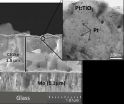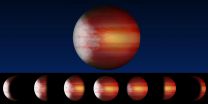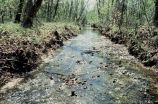(Press-News.org) The sun was just beginning to rise as two men headed down to the beach to board a small inflatable boat. Searching for abalone was on their agenda for the day. Their excitement was difficult to contain as they surveyed the coastline looking for sand ridges -- an important clue that abalone may be near. The two men, David Witting and Bill Hagey, share a passion for finding the now rare white abalone and understanding the movement and feeding behaviors of all abalone species.
David Witting, a NOAA Fisheries biologist, has been engaged in efforts to restore abalone populations on the West Coast for over a decade while working at NOAA. Bill Hagey, a developer of underwater instruments used by marine scientists, started working with the pioneer of abalone research, Dr. David Leighton, when he was in high school. Witting and Hagey began diving together and searching for abalone in San Diego, California's La Jolla and Point Loma areas a few years ago. Then, within a short time, this venture turned into a volunteer-based Citizen Science Group, made up of mostly scientists who are taking action to contribute new information to our understanding of southern California abalone populations.
"Bill and I were just two passionate people who thought we would go out on a few dive trips and find some white abalone," claims Witting. "At the time, we didn't realize this was going to turn into a community effort to learn more about abalone populations in southern California--with over 30 volunteer divers, two boats, and micro-scale maps of all abalone species encountered."
While Witting serves as one of the scientific advisors for this Citizen Science Group, Hagey handles all of the dive trip logistics, detailed trip reports, and engineering support. Last year, Hagey and his colleague Ronan Gray, from Sub Aqua Imaging Systems, Inc. designed a camera system that captured time-lapse images of a wild pinto abalone. The result was a video showing an individual abalone that remained within centimeters of the same location feeding on drift kelp during an entire two week period. This video is just one piece of the puzzle that Witting, Hagey, and others are hoping to discover about abalone movements.
Understanding abalone movement is a key element in determining actions to effectively aid in their recovery. Two individual abalone of opposite sexes need to be in close enough proximity for successful fertilization. To better understand abalone movements, Witting and Hagey are using additional cameras over longer time spans, such as 4-6 weeks. This time, they are recording the movements of two white abalone that are close to each other and hope to capture images of a spawning event. To understand longer-term movements, NOAA Fisheries received funding from the U.S. Navy to perform an acoustic tracking study of tagged pinto abalone, a surrogate species for white abalone. This study will begin in 2016.
"This citizen science group is collecting data that is helping NOAA Fisheries update the status of depleted abalone populations," states Witting. "As we get more data we will be able to provide critical information for restoring these populations."
Another key outcome from this group was a contribution to the understanding of pinto abalone populations. Amanda Bird, a member of the Citizen Science Group, is pursuing her Master's degree at California State University, Fullerton, studying the population dynamics of pinto abalone.
"We continue to find pinto abalone," notes Bird. "And due to the recent petition to list this species under the Endangered Species Act, it really motivated me to find out more about this species."
Bird completed the first comprehensive surveys for pinto abalone in southern California, building on studies conducted by California Department of Fish and Wildlife. Her work contributes to NOAA Fisheries' understanding of pinto abalone populations and was used in the agency's Status Review Report for Pinto Abalone. NOAA Fisheries made the decision to not list pinto abalone under the Endangered Species Act based on the findings of the status review, which were both released in December 2014.
The members of this citizen science group are really dedicated to aiding abalone recovery. When asked his reasons for leading the group, Hagey quoted John Lennon: "'If you want to save the white rhino -- go and save it and don't wait for someone to do it for you.' This is why I do this important work and why I will continue to support NOAA Fisheries' efforts," says Hagey proudly.
INFORMATION:
LEARN MORE about abalone: http://www.westcoast.fisheries.noaa.gov/protected_species/abalone/abalone.html
Many of us are familiar with electrolytic splitting of water from their school days: if you hold two electrodes into an aqueous electrolyte and apply a sufficient voltage, gas bubbles of hydrogen and oxygen are formed. If this voltage is generated by sunlight in a solar cell, then you could store solar energy by generating hydrogen gas.This is because hydrogen is a versatile medium of storing and using "chemical energy". Research teams all over the world are therefore working hard to develop compact, robust, and cost-effective systems that can accomplish this challenge. ...
For the first time, a researcher at the University of Waterloo has theoretically demonstrated that it is possible to detect a single nuclear spin at room temperature, which could pave the way for new approaches to medical diagnostics.
Published in the journal Nature nanotechnology this week, Amir Yacoby from the University of Waterloo, along with colleagues from University of Basel and RWTH Aachen University, propose a theoretical scheme that could lead to enhanced Nuclear Magnetic Resonance (NMR) imaging of biological materials in the near future by using weak magnetic ...
TORONTO, ON -- "Cloudy for the morning, turning to clear with scorching heat in the afternoon."
While this might describe a typical late-summer day in many places on Earth, it may also apply to planets outside our solar system, according to a new study by an international team of astrophysicists from the University of Toronto, York University and Queen's University Belfast.
Using sensitive observations from the Kepler space telescope, the researchers have uncovered evidence of daily weather cycles on six extra-solar planets seen to exhibit different phases. Such phase ...
In a new study published in the Protein & Cell, Chen-Yu Zhang's group at Nanjing University reports that small non-coding RNAs in maternal food can transfer through placenta to regulate fetal gene expression.
MicroRNAs (miRNA) are a class of noncoding RNAs with lengths of approximately 22 nucleotides that bind to target messenger RNAs to inhibit protein translation. In previous studies, the same group has found that plant miRNAs can enter into the host blood and tissues via the route of food-intake. The food-derived exogenous miRNAs are absorbed, packaged into microvesical ...
WASHINGTON, DC -- May 12, 2015-- A multidisciplinary group of US-based researchers has shown that the mixture of species found within natural bacterial communities in the environment can accurately predict the presence of contaminants such as uranium, nitrate, and oil. The findings, published this week in mBio, the online open-access journal of the American Society for Microbiology, show that the rapid sequencing of microbiomes in place at environmental sites can be used to monitor damage caused by human activity.
"This approach might be a general way for us to see anthropogenic ...
Nerve cells that produce dopamine for the purpose of transmitting signals to other cells affect numerous crucial brain functions. This becomes evident in diseases such as Parkinson's and schizophrenia, where dopamine transmission in the brain is impaired. In collaboration with researchers from Bonn, RUB scientists at the Mercator Research Group "Structure of Memory" have now identified in what way a specific form of this important cell is generated and which networks it forms in the course of brain development. In the process, the researchers discovered a data highway of ...
Amsterdam, May 12, 2015 - Wearable E-skin that can measure heart rate and blood pressure, and paper diagnostic machines the size of a credit card that can give instant readings on blood and saliva samples are two new bio-sensing technologies presented at Elsevier's 4th International Conference on Bio-Sensing Technology in Lisbon, Portugal on 12 May 2015.
Bio-sensors can detect and analyze data to give patients information on their heart rate and blood pressure, blood sugar and hormone levels, and even test whether they are infected with antibiotic-resistant bacteria. ...
SAN FRANCISCO, CA--MAY 11, 2015--Scientists have discovered a way to regrow bone tissue using the protein signals produced by stem cells. This technology could help treat victims who have experienced major trauma to a limb, like soldiers wounded in combat or casualties of a natural disaster. The new method improves on older therapies by providing a sustainable source for fresh tissue and reducing the risk of tumor formation that can arise with stem cell transplants.
The new study, published in Scientific Reports, is is the first to extract the necessary bone-producing ...
First there were canaries in coal mines, now there are microbes at nuclear waste sites, oil spills and other contaminated environments. A multi-institutional team of more than 30 scientists has found that statistical analysis of DNA from natural microbial communities can be used to accurately identify environmental contaminants and serve as quantitative geochemical biosensors. This study was sponsored by ENIGMA, a U.S. Department of Energy (DOE) Office of Science "Scientific Focus Area Program" based at the Lawrence Berkeley National Laboratory (Berkeley Lab).
"Changes ...
Researchers at Case Western Reserve University combined finely crafted nanoparticles with one of nature's potent disrupters to prevent the spread of triple-negative breast cancer in mouse models.
The highly aggressive cancer subtype is difficult to manage and, currently, the FDA has no approved targeted treatments. But striking results from a new study, published in the journal Cancer Research make the researchers optimistic they have a potential game-changer for triple negative cancer and more.
"There are multiple targets within a cell," said William Schiemann, professor ...


